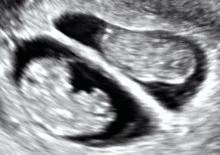122:
25:
363:
Mathiesen, UL; Franzén, LE (2002). "Increased liver echogenicity at ultrasound examination reflects degree of steatosis but not of fibrosis in asymptomatic patients with mild/moderate abnormalities of liver transaminases".
163:. In contrast, tissues with lower echogenicity are called "hypoechoic" and are usually represented with darker colors. Areas that lack echogenicity are called "anechoic" and are usually displayed as completely dark.
191:, and reflect a characteristic echo- this generates the strong and unique sonogram in contrast-enhanced ultrasound. Gas cores can be composed of
140:
around them. The standard representation is brighter color for higher echogenicity, giving the almost anechoic fluid an almost black appearance.
203:. Heavy gases are less water-soluble so they are less likely to leak out from the microbubble to impair echogenicity (McCulloch
155:
examinations. In other words, echogenicity is higher when the surface bouncing the sound echo reflects increased sound waves.
89:
61:
108:
159:
that have higher echogenicity are called "hyperechoic" and are usually represented with lighter colors on images in
121:
68:
420:
179:. This is because microbubbles have a high degree of echogenicity. When gas bubbles are caught in an ultrasonic
46:
75:
42:
244:
239:
176:
57:
223:
219:
could cause increased echogenicity in the liver, especially if the liver transaminases are elevated.
125:
415:
320:
Lindner, JR (2004). "Microbubbles in medical imaging: current applications and future directions".
160:
35:
207:, 2000). Therefore, microbubbles with heavy gas cores are likely to last longer in circulation.
215:
During ultrasound examinations, sometimes echogenicity is higher in certain parts of body.
136:
of almost 9 weeks. The mother’s and the twins’ bodies have a higher echogenicity than the
82:
8:
425:
405:
345:
297:
270:
249:
152:
377:
381:
337:
302:
349:
171:
Echogenicity can be increased by intravenously administering gas-filled microbubble
410:
373:
372:(7). Department of Internal Medicine, County Hospital, Oskarshamn, Sweden: 516–22.
329:
292:
282:
156:
227:
196:
184:
133:
172:
137:
399:
287:
385:
341:
306:
216:
188:
180:
333:
24:
200:
175:
to the systemic circulation, with the procedure being called
151:
is the ability to bounce an echo, e.g. return the signal in
271:"Ultrasound: Basic understanding and learning the language"
129:
192:
49:. Unsourced material may be challenged and removed.
269:Ihnatsenka, Barys; Boezaart, André Pierre (2010).
268:
210:
397:
362:
296:
286:
275:International Journal of Shoulder Surgery
109:Learn how and when to remove this message
366:Scandinavian Journal of Gastroenterology
120:
319:
398:
47:adding citations to reliable sources
18:
13:
14:
437:
23:
211:Reasons for higher echogenicity
166:
147:(sometimes as echogenecity) or
34:needs additional citations for
356:
322:Nature Reviews. Drug Discovery
313:
262:
1:
378:10.1016/s1590-8658(02)80111-6
255:
226:may also show an increase in
245:Echogenic intracardiac focus
240:Contrast-enhanced ultrasound
177:contrast-enhanced ultrasound
7:
233:
10:
442:
224:polycystic ovary syndrome
126:Obstetric ultrasonography
16:Ability to bounce an echo
421:Medical ultrasonography
288:10.4103/0973-6042.76960
161:medical ultrasonography
195:, or heavy gases like
141:
124:
43:improve this article
250:Medical ultrasound
153:medical ultrasound
142:
119:
118:
111:
93:
433:
390:
389:
360:
354:
353:
317:
311:
310:
300:
290:
266:
114:
107:
103:
100:
94:
92:
51:
27:
19:
441:
440:
436:
435:
434:
432:
431:
430:
416:Medical physics
396:
395:
394:
393:
361:
357:
334:10.1038/nrd1417
318:
314:
267:
263:
258:
236:
213:
197:perfluorocarbon
169:
134:gestational age
115:
104:
98:
95:
52:
50:
40:
28:
17:
12:
11:
5:
439:
429:
428:
423:
418:
413:
408:
392:
391:
355:
312:
260:
259:
257:
254:
253:
252:
247:
242:
235:
232:
230:echogenicity.
212:
209:
173:contrast agent
168:
165:
138:amniotic fluid
117:
116:
58:"Echogenicity"
31:
29:
22:
15:
9:
6:
4:
3:
2:
438:
427:
424:
422:
419:
417:
414:
412:
409:
407:
404:
403:
401:
387:
383:
379:
375:
371:
367:
359:
351:
347:
343:
339:
335:
331:
328:(6): 527–32.
327:
323:
316:
308:
304:
299:
294:
289:
284:
280:
276:
272:
265:
261:
251:
248:
246:
243:
241:
238:
237:
231:
229:
225:
220:
218:
208:
206:
202:
198:
194:
190:
186:
182:
178:
174:
164:
162:
158:
154:
150:
146:
139:
135:
131:
127:
123:
113:
110:
102:
91:
88:
84:
81:
77:
74:
70:
67:
63:
60: –
59:
55:
54:Find sources:
48:
44:
38:
37:
32:This article
30:
26:
21:
20:
369:
365:
358:
325:
321:
315:
281:(3): 55–62.
278:
274:
264:
221:
214:
204:
183:field, they
170:
167:Microbubbles
148:
145:Echogenicity
144:
143:
105:
96:
86:
79:
72:
65:
53:
41:Please help
36:verification
33:
222:Women with
217:Fatty liver
149:echogeneity
426:Ultrasound
400:Categories
256:References
69:newspapers
406:Acoustics
189:oscillate
181:frequency
99:July 2010
386:12236486
350:29807146
342:15173842
307:21472065
234:See also
201:nitrogen
185:compress
411:Hearing
298:3063344
228:stromal
157:Tissues
83:scholar
384:
348:
340:
305:
295:
205:et al.
85:
78:
71:
64:
56:
346:S2CID
199:, or
132:at a
130:twins
90:JSTOR
76:books
382:PMID
338:PMID
303:PMID
62:news
374:doi
330:doi
293:PMC
283:doi
193:air
128:of
45:by
402::
380:.
370:34
368:.
344:.
336:.
324:.
301:.
291:.
277:.
273:.
187:,
388:.
376::
352:.
332::
326:3
309:.
285::
279:4
112:)
106:(
101:)
97:(
87:·
80:·
73:·
66:·
39:.
Text is available under the Creative Commons Attribution-ShareAlike License. Additional terms may apply.
